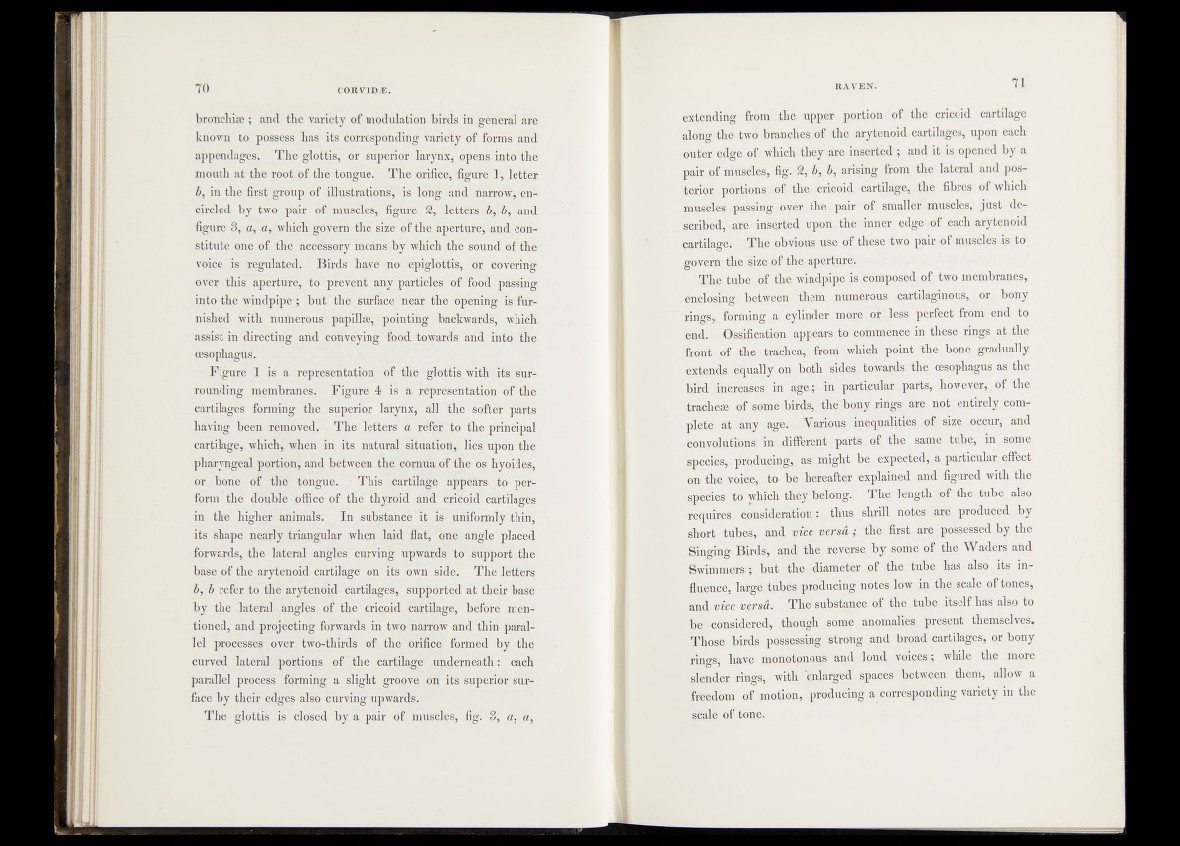
bronehiae; and the variety of modulation birds in general are
known to possess has its corresponding variety of forms arid
appendages. The glottis, or superior larynx, opens into the
mouth at the root of the tongue. The^orifiee, figure 1, letter
6, in the first group of illustrations, is long and narrow, encircled
by two pair of ;musclê^ figure i,!'letters b, b, and
figure 8, a, a, which govern the' size of the aperture, and constitute
one of the accessory means by- which the sriunch of the
voice is regulated. ' Birds -have no epiglottis, ot- covering
over this aperture, to prevent any particles; ofdfóml passing
into the windpipe; -but ' the surface near the opening-is furnished
with numerous papillae,; pointing -backwards, which'
nssist in directing and conveying fqod-towards ^ and into the
oesophagus.
> Figure 1 is a representation of the glottis with - its . surrounding
membranes, Figure é is a* representat^^^fuhle
cartilages forming the superior -larynx, all the softer parts
having been removed, The letters a refer to the principal
jcartilage, which, i?hen in its natural ^tuatio_r(, |0fes upori'tfe
pharyngeal portion? and between theicomua of the ^ChyMetfes,
for bone of the tongue. • This cartilage appears\\tp per^
form the double ?öffice\of the thyroid and cricoid cartilage's
in -the higher pnimals; In substance it is-uniformly~thin,
its shape nearly triangular when laid flat, one angle placed
forwards, the literal angles curving upwards to support the
base of the arytenoid cartilage on its own siaè, The letters
b, b refer to the .arytenoid cartilages, supported at their base
by the lateral angles of the cricoid cartilage, before mentioned,
and projecting forwards in two narrow and thin parallel
processes over two-thirds ofi. the orifice formed by the
curved lateral' portions of-the cartilage underneath: each
parallel process forming a slight groove on its superior surface
by their edges also curving upwards.
The glottis is closed by a pair of müscles, fig.' 8, a, a,
extending from the upper portion of the cricoid cartilage
along the two branched of the arytenoid cartilages, upon each
outer edge bf \wMch they are inserted ; and it is opened by a
pair of muscles, fig-#?* b, 5, arising from, the lateral and posterior
por%riisf;pf the cricoid cartilage, the fibres of which
muscles passing over the pair of smaller muscles, just described,
^ e inserted upon the dinner edge of each arytenoid
cartilage." The obvious-gsepf these two pair of muscles is to
govern the size-of the aperture.
The tube of the, windpipe is^mposed of two membranes,
enclosing ’be^#en4§|em numerous cartilaginous, or bony
'rings-, forming. a/,cylinder more o^less perfect 'from end to
end. Ossification appears, ,to commence, in these rings at the
frontiJfLfhe trachea, from which point the bone gradually
extends on both sides towards the eespphagus as the
bi|cfr| increases inlhri^fefytf-p^ticular parts, however, < of the
trachese o£.s«^% birds, the bony rings* are not .entirely complete.
at any Various inequalities of size occur, and
^jn!volutiSns in different parts of ii|te sam^^ube, m some
species, producing,,, as might be expected',., a particular effect
on theavo^^l -to he hereafter explained and figured with the
species to which they belong. The length of the tube also
requires consideration: thus shrill notes are produced by
short tubes, and vice versa; the first are .possessed by the
, Singitig Birds, and. the reverse b y some of the Waders and
Swimmers ; hut the diameter of the tp.be has also its influence,
large tubes producing notes low in the scale of tones,
and vice versa• The' substance of the tube itself bas also to
be considered, though some anomalies present themselves»
Those birds possessing" strong and broad cartilages, or bony
B l have monotonous and.loud, voices; while the more
.«lender rings, with enlarged spaces between them, allow a
freedom of motion, producingva_corresponding variety in the
scale of tone.